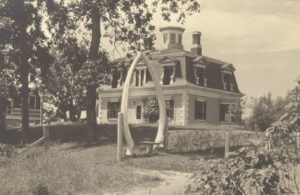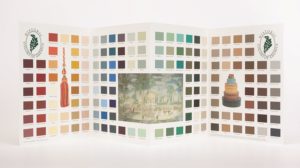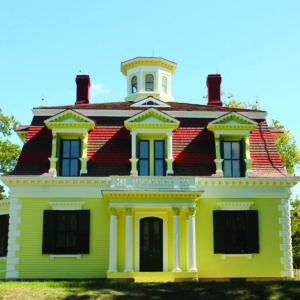Edward Penniman, considered one of the most successful sea captains in New England, traveled the world hunting whales in the mid-19th century and amassed enough wealth to retire to Eastham at 53.
The grand house he built in 1868 for his family on Fort Hill, overlooking the Atlantic and reflecting his status as someone who was both rich and well traveled, was a colorful one. The two-and-a-half-story house, built in the French Second Empire style Penniman likely saw on his travels, featured on its exterior yellow clapboards, white trim, black window sashes, and green window blinds. The mansard roof with dormers sported brown and red shingles, topped by a cupola, from which Capt. Penniman could watch ships passing.
Sarah Korjeff, the Cape Cod Commission’s historic preservation specialist, said that considerable research was done on the original paint colors before the exterior was restored, so what you see there now is likely very close to what the house looked like in Penniman’s day.
The Penniman house is reputed to be the first house in Eastham to have indoor plumbing, with a water collection system on the roof that led to a large tank in the attic that supplied water to the kitchen and bathroom. It had some other fancy features, too — the Eastham Historical Society website describes it as an “early trophy home” — notably, a decorative wooden fence with a gate made from a whale’s jawbone.

The National Park Service, which purchased the house in 1963, removed the whalebone gate for preservation in 2018. The nonprofit Friends of the Cape Cod National Seashore in 2016 covered half the cost of a restoration that brought back the yellow color thought to be similar to what Capt. Penniman would have chosen.
The evolution of paint colors used in New England from Colonial times through the Victorian era was influenced by the architectural period, one’s wealth, and the availability of the hues. There was a practical question, too — was paint necessary?
“In the 17th and early 18th centuries, the wood used for shingles and clapboard was old growth wood,” explained Sally Zimmerman, a historic preservation consultant. “It had a tight grain and was very durable. It didn’t need the protection.” That’s why many of the early homes here were not painted at all.
Paints weren’t made from synthetic dyes or available by the can until about 1870. Before that, paint was expensive and had to be mixed onsite. “Frequently, only the front of the house was painted,” Zimmerman said. The Cape’s salty breezes weathered the wood on the remaining exterior surfaces to a silvery gray or very dark brown. “That’s why you see so many museums that are dark brown,” she said.
Dark colors were typical of the 17th and 18th centuries up to the American Revolution. So-called barn reds made from iron oxide were particularly popular and relatively inexpensive. Various shades of gray were made from burned animal bones. Shades of pea green and mustardy ochres were made from earth materials, ground and mixed with white lead and linseed oil.
It wouldn’t be unusual on the Cape to see a house painted white on the front and the cheaper barn red on the sides and back, said Jay Camp, chair of the Eastham Historical Society. “Later on, when they developed shingling, they would shingle three sides and use clapboard on the front,” he explained.

Inside the home, during the 1700s and through much of the 1800s, walls were made of plaster and treated with a whitewash made with lime. Plaster was easy to come by on Cape Cod — one could simply grind up shells to make it.
Only the wooden elements of the interiors, such as paneling, wood frames, and beams, were painted. But the homes of the wealthy sported more paneling and less plaster, and therefore showcased more color. Popular interior colors in the Federal and Greek Revival architectural period, from 1780 to 1840, particularly in more urban areas, included peaches and brighter pastels. On the Cape, however, said Zimmerman, “you probably didn’t see a lot of color inside until the 1840s and ’50s.” That’s because most people here lived pretty simply, she explained. “As far as the status of paint colors, there were more expensive colors if we were talking Monticello, but not so much on the Cape.”
Exteriors during that same period were frequently white or off-white with a similar color trim, according to Korjeff, like the Truro Town Hall, a Greek Revival structure built in 1848. Dark colors, like green or black, were used for shutters, sashes, and doors. Built in 1802, the Federal-style house at 11 Shore Road in North Truro, currently the home of Truro Vineyards, is another example of the color combinations of the era.
Synthetic colors began to be made around the time of the Civil War, as part of the Industrial Age. “There is better production, and the paint is stored in cans,” said Leigh Schoberth, a preservation expert at Historic New England. As more colors became available, new trends emerged.

In the Victorian Era of the second half of the 19th century, strong contrasts were favored, and three-color schemes became the norm for building exteriors. Provincetown Town Hall was built in 1886, and when it was restored in 2009, Korjeff said, considerable research was done before colors were selected. Now, Korjeff said, its colors (they include green, yellow, and black on the exterior and an intense peach inside) are “a great example of late 1800s color use.”
Those restoring or caring for older homes will find it easy to find historic colors — they are produced by all the major paint manufacturers and are available at local hardware stores. And the rules around color are not generally restrictive. Most home owners are free to make their own color choices, even if they are in historic districts, Korjeff said. The reason, she explained, is that “most preservationists believe that since color is changeable and reversible, it does no damage to the historic resource.”
That changeability has a long history, said Zimmerman. “Color was a pendulum that went back and forth between dark and light, bright and muted,” she said, with styles brought home by high status people who traveled and read. The larger public, she said, would “swim along the tide,” following trends, “just the same as now.”



